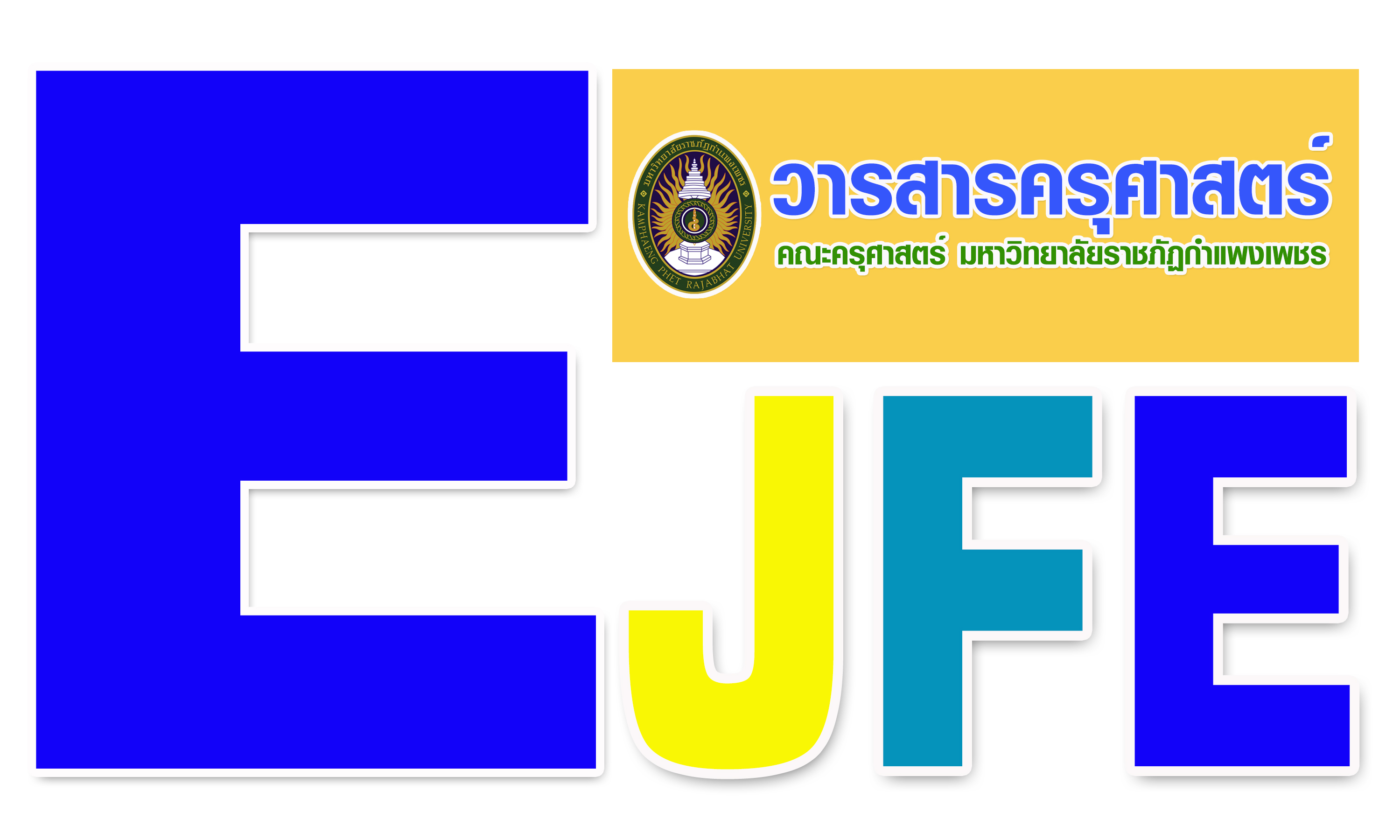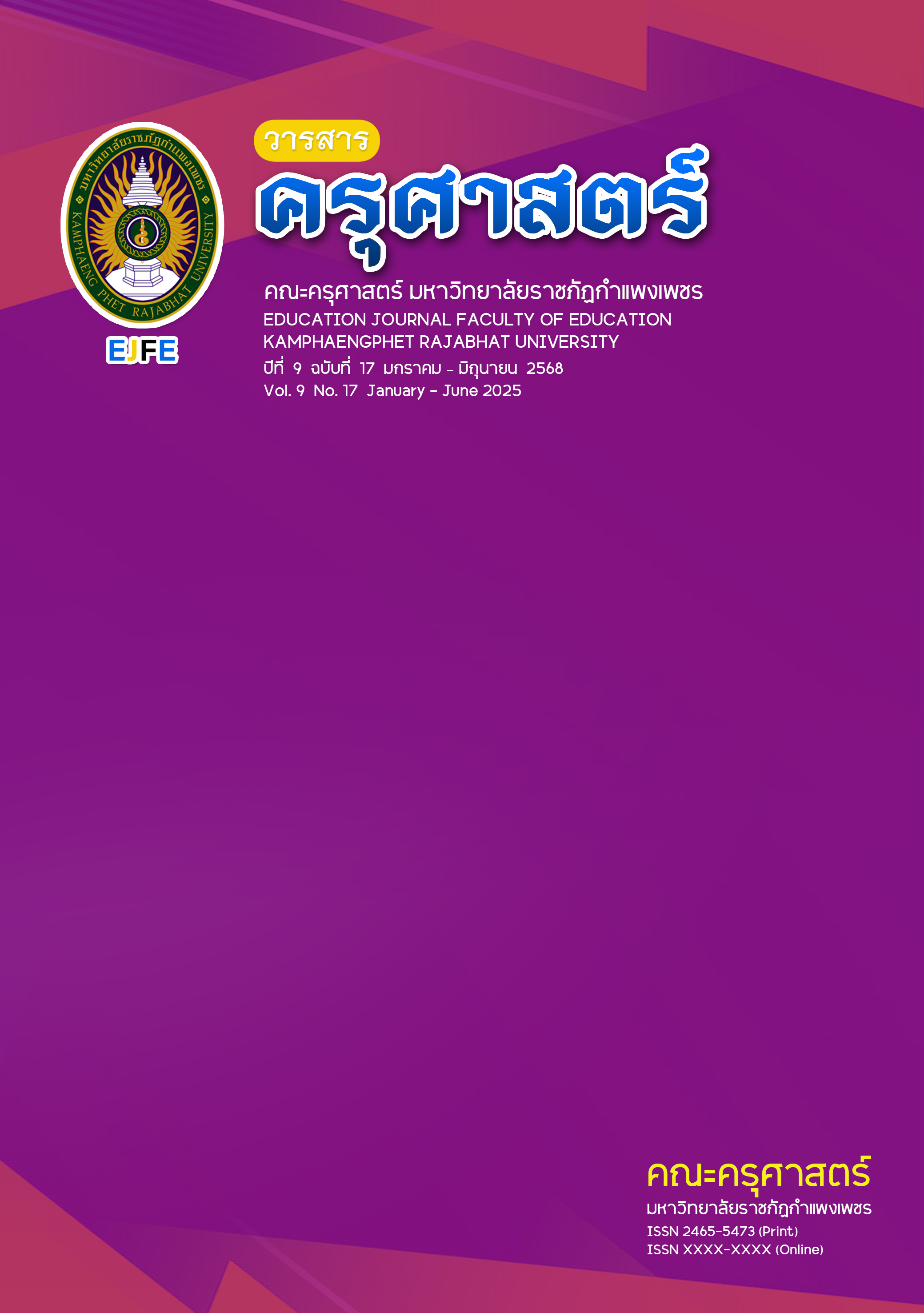A STUDY OF THE ABILITY TO SOLVE MATHEMATICAL PROBLEMS ON PERCENTAGE BY USING CONTEXT - BASED LEARNING MANAGEMENT WITH KWDL TECHNIQUES OF GRADE 5 STUDENTS
Main Article Content
Abstract
The objectives of this research were to 1) to examine the mathematical problem-solving ability of Grade 5 students on the topic of percentages. 2) to compare the mathematical problem-solving ability on the topic of percentages after using context-based learning combined with KWDL techniques against the 70% benchmark among Grade 5 students. and 3) Assess the students’ satisfaction with this learning approach. The sample consisted of 27 Grade 5 students from the Demonstration School of Buriram Rajabhat University, Mueang District, Buriram Province, during the second semester of the 2024 academic year, selected through cluster random sampling The research instruments included: 1) Nine lesson plans developed for the study 2) a subjective test comprising five mathematical problem-solving questions on percentages. and 3) a 17-item questionnaire assessing student satisfaction with the context-based learning combined with the KWDL technique. Data were analyzed using percentage, arithmetic mean, standard deviation, and one-sample t-test.
The results of the study were as follows: 1) Twenty-Three students represent eighty-five point nineteen percent of all students possess the ability to solve mathematical problems in all four areas: understanding the problem, analyzing and planning solutions, executing the solution, and summarizing the answer; 2) the students’ problem-solving abilities in percentages exceeded the 70 % benchmark, with a statistically significant difference at the 0.05 level; and 3) overall, the students’ satisfaction with the context-based learning approach combined with the KWDL technique was at the highest level.
Article Details

This work is licensed under a Creative Commons Attribution-NonCommercial-NoDerivatives 4.0 International License.
CC Attribution-NonCommercial-NoDerivatives 4.0
References
กระทรวงศึกษาธิการ. (2560). ตัวชี้วัดและสาระการเรียนรู้แกนกลางกลุ่มสาระการเรียนรู้คณิตศาสตร์ (ฉบับปรับปรุง พ.ศ. 2560) ตามหลักสูตรแกนกลางการศึกษาข้อพื้นฐานพุทธศักราช 2551. กรุงเทพฯ : ชุมนุมสหกรณ์การเกษตรแห่งประเทศไทย.
กัญญภัสสก์ เอกภัทร์ชัยวงษ์. (2564). การพัฒนาผลสัมฤทธิ์ทางการเรียนคณิตศาสตร์ โดยใช้การจัดกิจกรรมการเรียนรู้แบบกลุ่มร่วมมือเทคนิค TAI ร่วมกับ KWDL ของนักเรียนชั้นมัธยมศึกษาปีที่ 4. วิทยานิพนธ์ ปริญญาครุศาสตร์มหาบัณฑิต. มหาสารคาม : มหาวิทยาลัยมหาสารคาม.
กัญภร เอี่ยมพญา. (2561). การพัฒนาวิชาชีพครู. นนทบุรี : 21 เซนจูรี่.
ชัยวัฒน์ สุทธิรัตน์. (2558). 80 นวัตกรรมการจัดการเรียนรู้ที่เน้นผู้เรียนเป็นสำคัญ.(พิมพ์ครั้งที่ 6). นนทบุรี : พี บาลาซ์ดีไซด์แอนปริ้นติ้ง.
ฐิตามร หอกกิ่ง. (2566). การศึกษาผลสัมฤทธิ์ทางการเรียน หน่วยการเรียนรู้ ข้อมูลหรรษากับปริศนาบริบท รอบตัว และความฉลาดรู้ด้านคณิตศาสตร์ ของนักเรียนชั้นประถมศึกษาปีที่ 6 จากการจัดการเรียนรู้โดยใช้บริบทเป็นฐานรวมกับเทคนิค KWDL. วิทยานิพนธ์ ปริญญาครุศาสตรมหาบัณฑิต. นครราชสีมา : มหาวิทยาลัยราชภัฏนครราชสีมา.
ศุภกิตติ์ บุญเตี้ย. (2560). ผลของการจัดการเรียนรู้โดยใช้บริบทเป็นฐาน เรื่อง อัตราส่วนและร้อยละ ที่มีต่อผลสัมฤทธิ์ทางการเรียนวิชาคณิตศาสตร์ ความสามารถในการคิดอย่างมีวิจารณญาณ และคุณลักษณะใฝ่เรียนรู้ของนักเรียนชั้นมัธยมศึกษาปีที่ 2. ปริญญานิพนธ์มหาบัณฑิต. กรุงเทพฯ : มหาวิทยาลัยศรีนครินทรวิโรฒ.
วิภาดา นาเลา. (2562). การพัฒนาการจัดการเรียนรู้คณิตศาสตร์ที่ส่งเสริมทักษะการสื่อสารและ ทักษะการใช้เทคโนโลยีสารสนเทศ โดยใช้การจัดการเรียนร แบบขั้นบันได 5 ขั้น เพื่อการเรียนรู้ (QSCCS). วิทยานิพนธ์ ปริญญาครุศาสตร์บัณฑิต. กำแพงเพชร : มหาวิทยาลัยราชภัฏกำแพงเพชร.
เบญจลักษณ์ ภูสามารถ. (2563). การพัฒนาความสามารถในการแก้โจทย์ปัญหาคณิตศาสตร์ โดยใช้กิจกรรมการเรียนรู้เทคนิค KWDL ของนักเรียนชั้นประถมศึกษาปีที่ 5. วิทยานิพนธ์ ปริญญาครุศาสตร์มหาบัณฑิต. มหาสารคาม : มหาวิทยาลัยราชภัฏมหาสารคาม.
สถาบันทดสอบทางการศึกษาแห่งชาติ. (2566). รายงานผลการประเมินคุณภาพผู้เรียน (National Test: NT) ชั้นประถมศึกษาปีที่ 3 ปีการศึกษา 2565. บุรีรัมย์ : โรงเรียนสาธิตมหาวิทยาลัยราชภัฏบุรีรัมย์.
Bennett, J. and Holman, J. (2002). Context-based Approaches to the teaching of Chemistry: what are they and what are what are their Effects. In Chemical Education: Toward Research-based Practice, 165-184. Netherlands: Kluwer Academic Publishers.
Shaw, J. M. (1997). Cooperative Problem Solving : Using K-W-D-L as an Organizational Technique. New York : McGraw-Hill.


